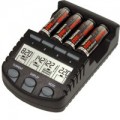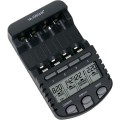Charge current (all channels)
The highest current provided by a multi-channel charger (see "Independent channels") at full load, with all slots (and, accordingly, channels) operating. In fact, a guaranteed maximum current provided by a multi-channel charger, regardless of the number of channels involved.
For the total charge current, see “Maximum charge current. Here we note that the full load is a rather complex mode in which the current strength can decrease. Therefore, this parameter is specified separately.
Drip charge
Ability to operate the device in
drip charge mode.
Drip charging is called charging a battery at low currents — on the order of several tens of milliamps — used to compensate for self-discharge ("volatilization" of accumulated energy over time). This function is relevant mainly for Ni-Cd and Ni-Mh batteries, which have quite significant self-discharge rates: it allows you to constantly keep them fully charged. This is especially useful in cases where the battery may be needed at any time (but it is not known exactly when).
Polarity test
A system that determines the location of the "plus" and "minus" of the connected battery and determines whether these contacts correspond to the contacts of the charger itself. The capabilities of such systems may be different: some, in the event of an error, issue a warning signal and block the power supply, others are able to automatically switch the polarity on the contacts, depending on which side the battery is installed. In any case,
checking the polarity minimizes the possibility of connection errors and the corresponding consequences.
Short circuit protection
Short circuit protection function . Such a short circuit can occur both during charging (for example, due to a malfunction of the connected battery or a foreign object getting between the contacts), and during discharging (due to a failure already in the memory itself). In any case, a short circuit leads to a sharp increase in current strength and abnormal loads on equipment, the consequences of which can be breakdowns and fires. To avoid this, short circuit protection is used - usually in the form of a fuse that turns off the power when the current increases sharply. Note that such a fuse can be both reusable and disposable, requiring replacement after operation.
Mains plug on cable
Chargers with a plug for connecting to a socket on the tip of the mains cable. Models
with a plug on the wire provide freedom of placement of the “charger” (especially in cramped free space near the outlet). So that the cable does not get tangled at hand, in many models it is made removable, which makes it easy to store the charger.

